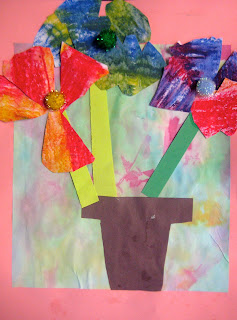Elmer has taken over our school!
K-1st grade (they are grouped together in my school) created their very own Elmer's. There were a lot of steps to this project but in the end I enjoy how they turned out. Each is unique in its own way. On day on and day two, after reading "Elmer" by David McKee we learned the basic geometric shapes needed to draw an elephant. We then worked step-by-step together drawing and coloring them in. Some K's took a while to catch on to drawing the shapes, which is to be expected, but I didn't want to hold back on my first project, especially since I still want to keep my 1st graders engaged.
We then talked about how colors mix together to make other colors. As they layered tissue papers with glue water they explored the possibilites of color mixing.
The real test was drawing out elephants on the back sides of our beautiful paper and cutting them out. I was crossing my fingers and we had no causalities:) All trunks, legs, and tails were safe (with the help of tape in some cases).
On the last day we talked about texture and created a ripped paper dirt floor on a blue sheet of paper. They were free to create a home for their elephants drawing trees, sun, watering holes, and animal friends with crayon.
In the end I'm happy we did not use a tracer, which was a consideration of mine. I actually sut out a bunch of tracers just in case everything went to crazy town. I love how each is unique in its own special way, just like Elmer!
































